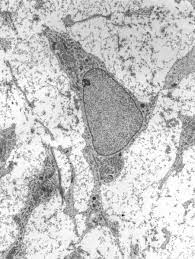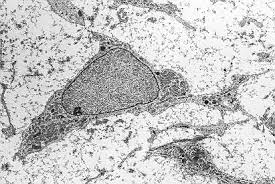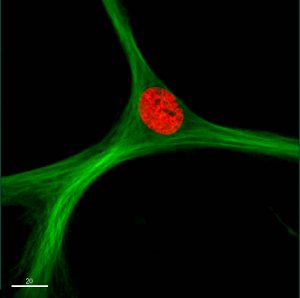Stem Cells
Stem Cells and the Future of Health Care
Although the medical field of Stem Cell Research is in its infancy, its potential for improving health care worldwide is unprecedented. In the next generation of medicine, there is no doubt that new procedures and methodologies utilizing stem cells will change how people across America and the globe live.
What is a Stem Cell?
Stem cells are the building blocks of a human being. Stem cells are cells that contain the genetic code to build something larger than themselves. When a human being is conceived, it begins as a microscopic ball of these stem cells. Over time, these cells differentiate and develop into the various cells,  tissues, and organs an organism must have to survive.
tissues, and organs an organism must have to survive.
Investing our time and energy in researching stem cells allows us to observe how a human is formed one tiny step at a time. Research involving Stem Cells and how to utilize them effectively in a medical environment will eventually change how physicians and surgeons practice medicine and conduct patient care.
Although human beings have a unique capacity for regeneration, there are limitations to how an adult stem cell can repair injured tissue or organs. For example, neurons have a minimal capacity to heal and regenerate. There is evidence that stem cells can regenerate tissue in ways that are simply impossible for adult cells because of their immature state.
Because of the unique nature of stem cells, in the future, the potential for stem cells to be utilized to repair or replace damaged organs and tissues can significantly alter the way that we treat everything from cancer to arthritis.
How Can Stem Cell Research Improve our Lives?
There are numerous ways in which Stem Cells may improve the way that we practice medicine. A number of medical afflictions have the terrible capacity to destroy tissue to an extent that regrowth and rehabilitation are not possible.
By manipulating Stem Cells, it will likely be possible to stimulate the regrowth of tissues and organs like the liver or kidneys that the body no longer can repair on its own. There is even potential that sometime in the future, stem cells may be used to completely regrow new organs for transplantation, vastly reducing the risk of rejection and reducing the need to wait on donor organs.
Researchers hypothesize that numerous diseases considered incurable today will likely find their cure via Stem Cell Research.
The benefits of Stem Cell Replacement can potentially lead to remarkable changes in how we treat cancer, arthritis, stroke, heart disease, spinal cord damage, diabetes, burns, and even neurological disorders such as Parkinson's and Alzheimer's.
In addition to the potential benefits of Stem Cell Treatments, Stem Cells are currently being used to foster an enhanced understanding of how our genetics contribute to the initial stages of cellular development.
By studying this initial stage of development at a cellular level, we can more fully realize how specific cells and cellular constructs develop improperly, contributing to birth defects and cancer.
Through a complete understanding of Stem Cell Replication and Differentiation, medical researchers will gain vital insights into eliminating the spread of many of these diseases of early development.
What are the Goals of Modern Stem Cell Research?
At this stage in Stem Cell Research, physicians and researchers are looking to enhance the effectiveness of current medical treatments and find ways to treat patients while diminishing the invasive nature of many forms of current treatment.
Although ideally, medical professionals would like to use the patient's stem cells, current Stem Cell Treatments are generally administered using cells received from a donor. Although these cells still have the potential to provide significant benefits, the ideal stem cells would come from the patient being  treated.
treated.
Even with modern techniques to prevent rejection, there is still the potential that the patient's immune system will reject the donor stem cells.
As we learn more about Adult Stem Cells, we will eventually be able to treat a patient with his or her own stem cells. By using a patient's own stem cells, the risk of rejection drops significantly and may even be removed completely. There are a number of hypotheses regarding how this goal may be achieved:
Harvesting adult stem cells from an individual and altering them in a laboratory environment develops into a specific type of tissue. After the tissue forms and develops, it could be transplanted to a target area of the body in need of treatment, where it could restore function lost through tissue damage.
A technique known as Therapeutic Cloning could be used to create embryos full of immature stem cells which would be identical to those of the individual.
A third technique to use Stem Cells for therapeutic advantage would be to naturally encourage stem cells within the body to perform healing functions. One scientific hypothesis is that it may be possible to design medications that would encourage a particular form of stem cell to multiply therapeutically within the patient.
This treatment would reduce the need to go under the knife to gain the therapeutic benefit of stem cell therapy.
At face value, the potential benefits of Stem Cell Treatment seem endless. Would it not be possible to utilize stem cells to heal or replace damaged or destroyed tissue within the patient? To reveal the actual healing capacity of Stem Cell Treatment, there are a number of questions that must be answered first:
How Effective will Stem Cell Treatments be Long-Term?
One of the primary reasons we grow older is because our cells age for various reasons. An important question must be answered is if Adult Stem Cell Treatments will malfunction or lose efficiency faster than cells naturally formed by the human body.
There is limited evidence regarding the long-term potential of Stem Cell Therapy.
What can we do to ensure that Stem Cell Treatments don't develop into uncontrolled tumors?
Stem Cells harvested from embryos are genetically designed to divide repeatedly and not develop differentiation. For Stem Cell Treatment to be effective, scientists have to be able to manipulate the stem cells into a desired form of differentiation.
Suppose the goal of differentiation is not reached. In that case, this can lead to tumor formation because the embryo will continue to divide and flood its immediate area with more undifferentiated cells. For Embryonic Stem Cells to be an effective treatment, they must be effectively and tightly controlled.
In both adult and embryonic stem cells, if the genes within the cells are not guided and appropriately regulated, it may lead to tumor development. There are questions regarding how stem cells will act when they have been active in a laboratory environment before transplantation.
There is a possibility that these cells may differentiate in a different way than stem cells that are harvested directly from a patient.
What would cause this?
The majority of cells in human physiology are not designed for infinite revision, and they definitely aren't designed to develop in a sterile laboratory environment. Numerous tissue types, such as skin cells and blood cells, have particular biological processes that control differentiation, division, and apoptosis after a certain length of time.
These cues are the result of biological signals received from the entire environment of an organ or organism.
For cells to divide indefinitely in a laboratory environment, the process of normal development must be stalled. The way that scientists achieve this form of artificial growth is to house the cells in a solution containing the nutrients vital for their survival and proteins that encourage their reproduction.
In most of these environments, many developmental signals in a living environment do not exist in the lab.
Evidence shows that some cells don't react as well to this environment as others. A certain percentage of the cells will not survive, and the cells more effectively designed to withstand non-finite growth will propagate.
 After a certain number of divisions in vitro, the remaining cells could hypothetically evolve so much that they no longer react effectively to the standard signals provided by their natural physiological ecosystem.
After a certain number of divisions in vitro, the remaining cells could hypothetically evolve so much that they no longer react effectively to the standard signals provided by their natural physiological ecosystem.
There are even theories that keeping stem cells in vitro for an extended period of time could even alter the genetic structure of the cells. These changes could encourage the development of tumorous growths.
Recreating the body's natural ecosystem within a lab is one of the most challenging aspects of stem cell research. It is actually one of the primary goals of global stem cell research across the globe.
For stem cell treatments to be maximally effective, we must learn how to store and develop stem cells in an environment that closely mimics their location within our body.
Importance of the Nanog Protein
Critical studies and advances in recent years give hope that we can extend the usefulness of stem cells, even those that have remained in vitro for an extended time. Recently, Stem Cell Researchers have discovered precisely how stem cells can persist in their undifferentiated state for an infinite period of time.
The study was endowed by a charity known as the Wellcome Trust, which provides independent funding to novel research regarding the enhancement of human and animal life. Longer researchers have discovered a unique protein that can preserve non-differentiated stem cells.
Another name for these cells is Pluripotent Stemcells. This means that stem cells can evolve into various types of tissue.
Although scientists for years have suspected that Nanog played a unique role in the control of differentiation, researchers from Cambridge have discovered that Nanog is actually the mechanism that controls the development and differentiation of stem cells.
By enhancing scientific knowledge regarding Nanog, researchers can more fully understand the mechanisms by which stem cells function. The more we understand stem cells, the more safely we can use them for more excellent medical treatments.
The Isolation of the Nanog Protein
Nanog had been previously hypothesized but was not isolated until a decade ago when it was discovered to play a significant role in maintaining pluripotency. Although researchers recognized its importance, they could not yet pinpoint exactly how Nanog prevented differentiation in stem cells.
In this Cambridge Study, scientists demonstrated that Nanog is the lynchpin of a complex balance of protein and gene maintenance which maintains the stem cells in the pluripotent stage.
Without the presence of Nanog, Stem Cells cannot remain indefinitely undifferentiated. Also, without the influence of Nanog, it is impossible to recalibrate fully developed cells to return to a state of pluripotency. the specific period in which Nanog must be present is during the last stage of reprogramming. Without the presence of Nanog, the stem cell gets locked in a state of partial development.
One medical representative from the Wellcome Trust Center, Doctor Silva, explains that the medical research demonstrates that Nanog has the specific power to maintain the property on non-differentiation indefinitely.
To more fully recognize the influence of Nanog, researchers must study more deeply the function of Nanog to determine precisely how the protein influences early human development during the embryonic phase.
The Importance of Understanding Pluripotency
To expand the usefulness of Stem Cell Therapies to a greater variety of potential treatments, it is vital to understand precisely how stem cells thrive in a pluripotent state and how they differentiate. Nanog research is an essential gateway into the future of Stem Cell Utilization.
By understanding the pluripotent nature of stem cells, researchers hope to one day convert adult cells back into their early forms so that they can be used to treat a variety of medical conditions more effectively and cheaply than ever thought possible.
Rather than be stuck with limited sources of stem cells, such as those acquired from donors, or those acquired from embryonic stem cells, scientists could revert adult cells into embryonic stem cells, then convert them into other vitally needed types of tissue such as nerve cells or kidney cells.
If scientists can make these hypotheses realities, numerous chronic diseases like Alzheimer's and Parkinson's could be treated more effectively or even wholly cured one day.
With the success of this research, we may one day be able to live far longer than we ever thought imaginable.
- 0001 Mesenchymal Stem Cells: The Future Of Rehabilitation [Last Updated On: February 12th, 2025] [Originally Added On: September 23rd, 2020]
- 0002 The Potential Role Of Gh-rh In Treating Alzheimer's [Last Updated On: May 29th, 2025] [Originally Added On: September 24th, 2020]
Word Count: 2025






